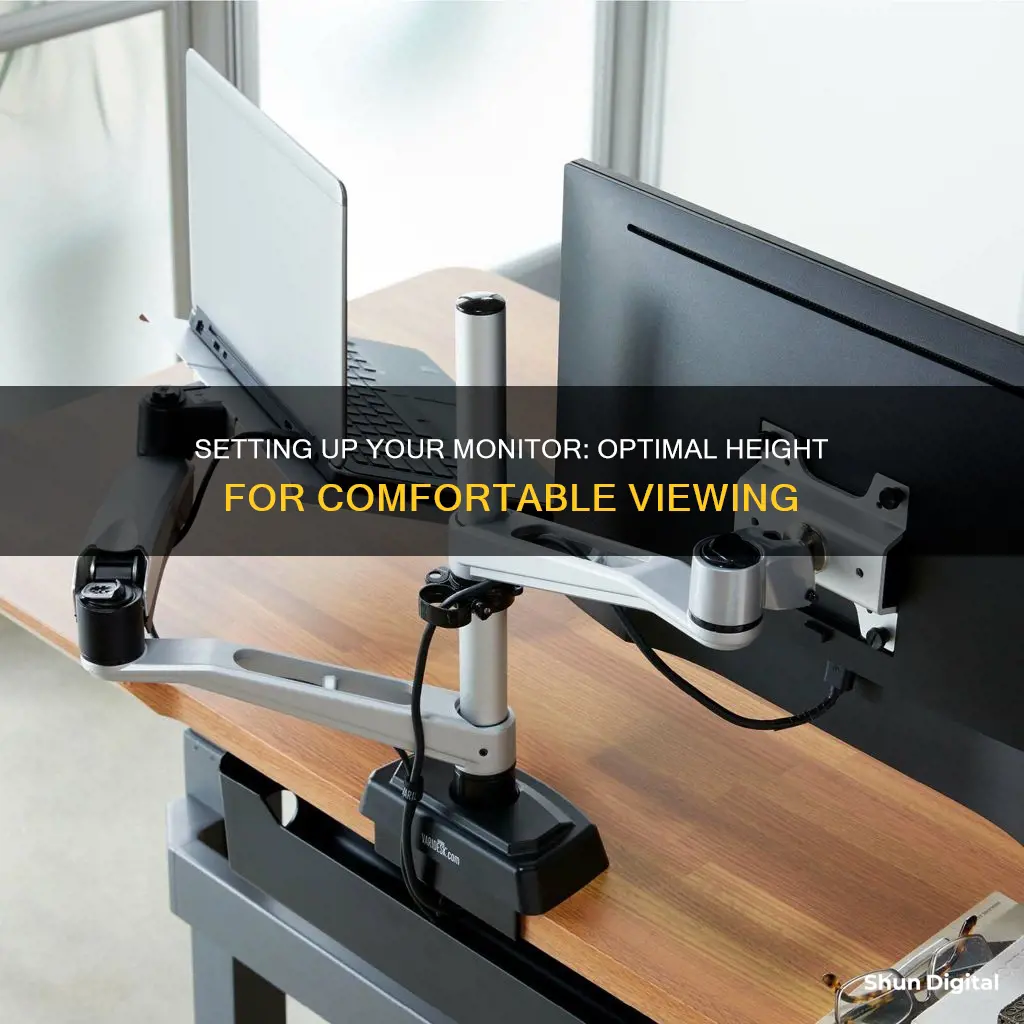
Setting up your monitor at the correct height is important to prevent health issues such as muscle strain, neck and back pain, and eye strain. The ideal height for a monitor is one that allows you to view the screen comfortably without having to tilt your head or strain your eyes.
The general rule of thumb is to position your eyes 1 to 3 inches below the top of the monitor frame, while maintaining a comfortable sitting posture. This placement ensures that you can view the majority of the monitor without putting unnecessary strain on your neck. Additionally, the monitor should be placed at an arm's length distance, which is typically between 50 and 100 cm away.
It's important to note that the height of your computer desk also plays a role in determining the ideal monitor height. Your desk should be at a height that allows you to place your feet flat on the ground, sit with your knees and elbows bent at a right angle, and position the keyboard and mouse level with your elbows.
| Characteristics | Values |
|---|---|
| Viewing distance | An arm's length away from the monitor |
| Monitor height | Eyes should be 1 to 3 inches below the top of the monitor |
| Screen angle | Tilted back by 10-20 degrees |
| Screen position | Directly in front of you |
What You'll Learn
- The ideal height for a monitor is to have your eyes 1 to 3 inches below the top of the monitor frame
- The monitor should be placed at eye level or slightly below
- The monitor should be placed at arm's length away
- The monitor should be tilted back slightly (10-20 degrees)
- The monitor should be positioned directly in front of you

The ideal height for a monitor is to have your eyes 1 to 3 inches below the top of the monitor frame
This height allows you to view most of your monitor without having to tilt your head, reducing the amount of neck strain you experience throughout the day. It is also important to consider the distance between you and your monitor, as sitting too close or too far away can cause eye strain and headaches. A good rule of thumb is to sit an arm's length away from your monitor.
If you are using two monitors, you should position them as close together as possible, with their inside edges touching. If you are using one screen as your primary monitor, you should position yourself, your keyboard and your mouse directly in front of it, with the secondary monitor off to the side. If you are using both screens equally, position yourself in the middle of the two monitors.
You may also need to adjust the tilt of your screen to reduce glare, depending on the lighting in your office.
Free LCD Monitor Recycling: Where and How?
You may want to see also

The monitor should be placed at eye level or slightly below
To avoid neck strain, it is important to set up your monitor at the correct height. The ideal height for a monitor is for it to be placed at eye level or slightly below.
The height of your computer monitor will determine the daily stress you put on your neck. Issues with the neck can cause pain that affects the quality of your work, from throbbing headaches to back pain. Research has shown that tilting your head down by just 15 degrees adds an extra 27 lbs of pressure to your spine.
To avoid this, you should place your monitor at eye level or slightly below. You should be positioned so your eyes are 1 to 3 inches below the top of your monitor frame while in a comfortable sitting posture. This allows you to view most of your monitor without having to tilt your head.
Our eyes naturally see more visuals below the horizontal line of sight than above. To test this, next time you walk down a hallway, check whether you see more of the floor or the ceiling when looking straight.
It is also important to be mindful of the distance between you and your monitor. Sitting too close to your monitor can cause eye strain and has been linked to issues such as headaches, neck pain, and nearsightedness. Sitting too far from your monitor has also been linked to eye strain and headaches. A good rule of thumb is to sit an arm's length away from your monitor.
Powering Your ASUS Monitor: Wattage Requirements Explained
You may want to see also

The monitor should be placed at arm's length away
The optimal distance between you and the monitor is between 50cm and 100cm. If your monitor is larger than 20 inches, you should move the monitor further away. For every 7 additional inches of screen size, move the monitor 12 inches away. The most important thing is that you should be able to view your monitor without squinting or turning your head.
If you are using two monitors, you should place them as close as possible to each other, with their inside edges touching. The monitors should be at a slight inward angle. If you are using one screen more than the other, place the primary monitor directly in front of you, following the arm's length rule. The secondary monitor should be placed beside the primary monitor on the side of your dominant eye, at the same height and distance.
Bail Ankle Monitors: Who Wears Them and Why?
You may want to see also

The monitor should be tilted back slightly (10-20 degrees)
To relieve aches and pains that can gradually creep in from incorrect monitor height, it is recommended that the monitor is tilted back slightly by 10-20 degrees. This is because our eyes naturally trend straight ahead and downward when at rest.
The correct monitor height is important as it can cause health issues such as muscle strain and neck and back pain if not set up properly. The height of the monitor determines the daily stress on your neck. A research study found that tilting your head down by 15 degrees added an extra 27 lbs of pressure to your spine.
To avoid this, the monitor should be placed at eye level or slightly below it. The ideal position for your eyes is 1 to 3 inches below the top of the monitor frame. This will allow you to view most of the monitor without having to tilt your head.
The correct monitor height will also depend on individual factors such as sitting posture and monitor size. For example, a six-foot-tall person should not have their screen in the same position as a five-foot-three-inch person.
Additionally, the presence of windows and other sources of light should be considered when setting up the monitor. To avoid glare, change the screen's tilt to mitigate the effects of overhead sources.
Enhance Your Monitor's Clarity: Remove Blur for Sharp Visuals
You may want to see also

The monitor should be positioned directly in front of you
If you are using a dual-monitor setup, place your primary monitor directly in front of you, and position your second monitor beside the primary monitor on the side of your dominant eye, at the same height and distance.
The monitor should be placed at eye level, or slightly below. A good rule of thumb is to position your eyes 1 to 3 inches below the top of the monitor frame. This will depend on your height, but generally, your screen should be placed anywhere between eye level and 30 degrees below your line of sight.
To find the correct height, sit up straight in your chair, with your feet flat on the floor and your elbows and knees bent at a right angle. Position the keyboard and mouse level with your elbows. Your monitor should be placed so that the top of the screen is at eye level.
The distance between you and the monitor is also important. You should be able to see the full screen without having to move your head or neck. Sit a comfortable distance from your monitor to protect your eyes and neck. For most people, this is between 50cm and 100cm, or an arm's length distance.
Connecting Ancient Monitors to 1080 FTW: A Comprehensive Guide
You may want to see also
Frequently asked questions
The height of your monitor will determine the amount of daily stress you put on your neck. The top of your screen should be at eye level, with your eyes 1 to 3 inches below the top of your monitor frame. This will allow you to view most of your monitor without having to tilt your head.
Identify which monitor is your primary monitor and which is your secondary. The primary monitor should be placed directly in front of you, with the secondary monitor placed beside it on the side of your dominant eye, at the same height and distance.
You should sit approximately an arm's length away from your monitor. If you have a monitor that is larger than 20 inches, move the monitor further away. As a rule of thumb, move it 12 inches away for every 7 additional inches of screen size.
The height of your computer desk will play a part in determining the height of your monitor. Your desk should be at a height that allows you to place your feet flat on the ground, sit and work with your knees and elbows bent at a right angle, and position the keyboard and mouse level with your elbows.







